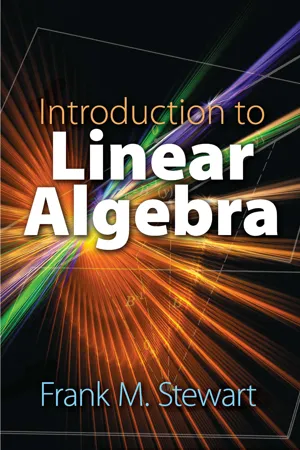
- 304 pages
- English
- ePUB (mobile friendly)
- Available on iOS & Android
Introduction to Linear Algebra
About This Book
Introduction to Linear Algebra stresses finite dimensional vector spaces and linear transformations. Intended for undergraduate majors in mathematics, applied mathematics, chemistry, and physics, the treatment's only prerequisite is a first course in calculus. Proofs are given in detail, and carefully chosen problems demonstrate the variety of situations in which these concepts arise.
After a brief Introduction, the text advances to chapters on the plane, linear dependence, span, dimension, bases, and subspaces. Subsequent chapters explore linear transformations, the dual space in terms of multilinear forms and determinants, a traditional treatment of determinants, and inner product spaces. Extensive Appendixes cover equations and identities; variables, quantifiers, and unknowns; sets; proofs; indices and summations; and functions.
Frequently asked questions
Information
CHAPTER I

INTRODUCTION


Table of contents
- Cover
- Title Page
- Copyright Page
- Dedication
- Contents
- Preface
- Note to the Reader
- Chapter I Introduction
- Chapter II The PLANE
- Chapter III Linear Dependence, Span, Dimension, Bases, Subspaces
- Chapter IV Linear Transformations
- Chapter V The Dual Space; Multilinear Forms; Determinants
- Chapter VI Determinants: A Traditional Treatment
- Chapter VII Inner Product Spaces
- Appendix A. Equations and Identities
- Index of Symbols
- Index
- List of Definitions, Theorems, Corollaries, and Lemmas